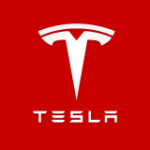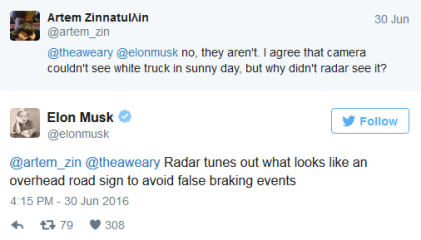Re: In my humble opinion
junko.yoshida 7/8/2016 11:16:06 AM
Olaf, that's a good point. No, owners don't read thick manuals anymore. Everyone expects
"out of the box" experience. If you had to look it up in the manual or searching answers in
wikihow, yeah, that's definitely a turn off.
What actually bothers me about this case is that the whole Tesla "fanboy" community really
encouraged reckless driving behaviors -- i.e. using ADAS system as "autonomous" hands-
free driving. Posting their own "look ma, no hands" video clip on YouTube, enthralled by
the number of clicks it gets. On top of that, he gets "retweet" from Elon Musk, which makes
the driver feel as though he can die in heaven.
You know how the circular nature of social media goes. Everyone follows what everyone
else seems to be doing, and kids himself that it's OK to drive his Tesla hands-free.
Calling ADAS as "Autopilot" is the biggest misnomer of this decade in my humble opinion.
Copyright © 2016 UBM All Rights Reserved
----------------------------------------------
Re: good article
junko.yoshida 7/8/2016 11:03:28 AM
Eric, thanks for chiming in. This msg coming from you -- really one of the pioneers of CMOS
image sensors -- means a lot to us.
Yes, I am sure that Tesla and all the technologies suppliers have a better handle of what
went wrong. But you raise a good question here.
If you, as a driver, are blinded by the sun, you slow down -- rather than telling yourself,
"I can't classify what's in front of me."
The car manufacturer -- and tech suppliers, too -- must do a much better job in spelling out
the limitations of their products.
The public at this day and age tends to be too trusting of technologies
.
Copyright © 2016 UBM All Rights Reserved
----------------------------------------------
Re: Truck safety regulations
sixscrews 7/7/2016 7:41:00 PM
Trucks do have rear crash barriers but not side barriers although I have seen more and
more trailers with side airfoils intended to reduce aerodynamic drag - reinforcing these as
crash barriers would be a no-brainer. On the other hand, no matter what kind of barrier you
have a 65 mph impact is likely to be lethal or at least result in serious injury to the front seat
occupants.
I appreciate the endorsement of certification of automitive software. Carmakers and others
will carry on about gov't interference but if you had a chance to read some of the code in
the Toyota TCM it would make your eyes spin - sphagetti code doesn't even begin to
describe it. I wrote better code (I think) back in 1978 when we were using punch cards.
There are lots of excellent software engineers and managers who know how to get them to
produce excellent code - all it takes is for the auto industry to get smart and hire them.
But they are cheap and dumb, IMHO, and more focused on marketing than product
development (with some exceptions - Ford's focus on turbochargers is impressive but I
have no idea what their software looks like).
And then there is Volkswagen's diesel emission cheat software - you can do all kind of
things in code provided nobody but your supervisors look at it.
wb/ss
Copyright © 2016 UBM All Rights Reserved
----------------------------------------------
Re: Who is responsible for the accident?
sixscrews 7/7/2016 4:47:40 PM
Your comments are dead on - what was going on here?
However, if an autopilot system cannot compensate for stupid
drivers of other vehicles on the same roadway then it's worse
than useless - it's a loaded weapon pointed straight at the
head of the vehicle operator - whose primary responsibility is
to keep aware of the situation.
So, if Tesla is marketing this as a 'play your DVD and let us do
the driving' then they are worse than fools - they are setting
their clients up for fatal crashes.
At this time there is no software that can anticipate all the
situations that will occur on a roadway and anyone who claims
otherwise is ignorant of the state of software circa 2016.
And this brings me to one of my favoride dead horses – the
NHTSA has no authority to certify vehicular control software
and this allows manufacturers to release software the is
developed by a bunch of amatuers with no idea of the
complexities of real time control systems (see Toyota throttle
control issues revealed in the Oklahoma case 18 months ago).
Congress - or whatever group of clowns that masquerade as
Congress these days - must implement - or allow NHTSA or
another agency- to create set of regulations similar to those
applying to aircraft flight control systems. A vehicle operating
in a 2-D environment is just as dangerous as an aircraft
operating in a 3-D environment and any software associted
with either one should be subject to the same rules.
Automakers are behaving as if the vehicles they manufacture
are still running on a mechanical distributor-points-condensor-
coil system with a driver controlling manifold pressue via the
'gas pedal' as was true in 1925. They fought air bags,
collapasible steering columns, safety glass and dozens of
other systems from the '20s to the present. Enough is enough.
Mine operators who intentionally dodge safety rules spend
time behind bars (or maybe - provided the appeals courts
aren't controlled by their friends). So why shouldn't
automakers be subject to the same penanties? Kill your
customer - go to prison, do not pass GO, do not collect $200.
The engineering of automobiles is not a game of lowest bidder
or chepest engineer; given the cost of vehicles today it should
be the primary focus of company executives, not something to
be passed off as an annoyance and cost center with less
improtance than marketing.
It's time for automakers to step up and take responsibility for
the systems they manufacture and live with certification of the
systems that determine life or death for thier customers.
wb/ss
Copyright © 2016 UBM All Rights Reserved
===============================
Tesla Crashes BMW-Mobileye-Intel
Event
Recent auto-pilot fatality casts pall
Junko Yoshida, Chief International
Correspondent
7/1/2016 05:32 PM EDT
---------------------------------------------
(selected comment - by the article author):
Re: Need information
junko.yoshida 7/2/2016 7:18:45 AM
@Bert22306 thanks for your post.
I haven't had time to do a fully story but here's what we know
now:
You asked:
1. So all I really want to know is, why did multiple redundant
radar and optical sensors not see the broad side of a
trailer?
Tesla Model S doesn't come with "multiple redundant radar
and optical sensors." It has one front radar, one front
monocular Mobileye optical camera, and a 360-degree set of
ultrasonic sensors.
In contrast, similar class cars like Mercedez Benz comes with
a lot more sensing hardware devices including short-range
radar, multi-mode radar, stereo optical camera in addition to
what Tesla model S has.
But that's besides the point. More sensing devices obviously
help but how each carmaker is doing sensor fusion and what
sort of algorithms are at work are not known to us. There are
no good yardsticks available to compare different algorithms
against one another.
2. Must have been a gymongous radar target, no?
Yes, the truck was a huge radar target. But according to Tesla's
statement, "The high, white side of the box truck, combined
with a radar signature that would have looked very similar to
an overhead sign, caused automatic braking not to fire."
In other wrods, Tesla's autopilot system believed the truck was
an overhead sign that the car could pass beneath without
problems.
Go figure.
3. Why the driver didn't notice is easily explained.
There have been multiple reports that the police found a DVD
player inside the Tesla driver's car. There have been
suggestions -- but it isn't confirmed -- that the driver might have
been watching a film when the crash happened. But again,
we don't know this for sure.
4. Even though this was supposed to be just assisted
driving, one might assume that the driver was distracted
You would think. It's important to note, however, that this driver
killed in Tesla autopoiot carsh has been known to be a big
Tesla fan, and he posted a number of a viral video on his
Model S.
Earlier this year, he posted one video clip showing his Tesla
avoiding a close call accidet with autopilot engaged. (Which
obviously got an attention and a tweet back from Elon Musk...)
Here's the thing. Yes, what autopilot did in that video is cool,
but it's high time for Musk to start tweeting the real limitations
of his autopilot system.
5. Saying things like "We need standards" is so peripheral!
I beg to differ, Bert.
As we try to sort out what exactly happened in the latest Tesla
crash, we realize that there isn't a whole lot of information
publicly available.
Everything Google, Tesla and others do today remain private,
we have no standards to compare them against. The
autonomous car industry is still living in the dark age of siloed
commuity.
I wrote this blog because I found interesting what Mobileye's
CTO had to say in the BMW/Mobileye/Intel press conference
Friday morning. There were a lot of good nuggets there.
But one of the things that struck me is this: whether you like it
or not, auto companies must live with regulations. And
"regulators need to see the standard emerging," as he put it.
As each vendor develops its own set of sensor fusing, own set
of software stack, etc., one can only imagine complexities
multiplying in standards for testing and verifying autonomous
cars.
Standards are not peripheral. They are vital.
Copyright © 2016 UBM All Rights Reserved
===============================





